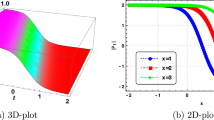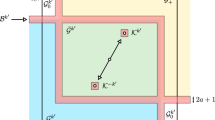Abstract
Gross–Pitaevskii and nonlinear Hartree equations are equations of nonlinear Schrödinger type that play an important role in the theory of Bose–Einstein condensation. Recent results of Aschbacher et al.(3) demonstrate, for a class of 3-dimensional models, that for large boson number (squared L 2norm), \(N\), the ground state does not have the symmetry properties of the ground state at small \(N\). We present a detailed global study of the symmetry breaking bifurcation for a 1-dimensional model Gross–Pitaevskii equation, in which the external potential (boson trap) is an attractive double-well, consisting of two attractive Dirac delta functions concentrated at distinct points. Using dynamical systems methods, we present a geometric analysis of the symmetry breaking bifurcation of an asymmetric ground state and the exchange of dynamical stability from the symmetric branch to the asymmetric branch at the bifurcation point.
Similar content being viewed by others
REFERENCES
R. Adami, C. Bardos, F. Golse, and A. Teta, Towards a rigorous derivation of the cubic NLSe in dimension one, preprint (2003).
S. Albeverio, F. Gesztesy, R. Høegh-Krohn, and H. Holden, Solvable Models in Quantum Mechanics(Springer-Verlag, New York, 1988).
W. H. Aschbacher, J. Fröhlich, G. M. Graf, K. Schnee, and M. Troyer, Symmetry breaking regime in the nonlinear Hartree equation, J. Math. Phys. 43:3879–3891 (2002).
R. D'Agosta and C. Presilla, States without a linear counterpart in Bose-Einstein condensates, Phys. Rev. A 65:043609 (2002).
F. Dalfovo, S. Giorgini, L. P. Pitaevskii, and S. Stringari, Theory of Bose-Einstein condensation in trapped gases, Rev. Modern Phys. 71:463–512 (1999).
L. Erdös and H. T. Yau, Derivation of the nonlinear Schrödinger equation from a many body Coulomb system, Adv. Theor. Math. Phys. 5:1169–1205 (2001).
A. Floer and A. Weinstein, Nonspreading wave packets for the cubic Schrödinger equation with a bounded potential, J. Funct. Anal. 69:397–408 (1986).
Yu. B. Gaididei, S. F. Mingaleev, and P. L. Christiansen, Curvature-induced symmetry breaking in nonlinear Schrödinger models, Phys. Rev. E 62:R53–R55 (2000).
R. H. Goodman, P. J. Holmes, and M. I. Weinstein, Strong NLS soliton-defect interactions, submitted to Physica D(2003).
M. Grillakis, Analysis of the linearization around a critical point of an infinite dimesional Hamiltonian system, Comm. Pure Appl. Math. 43:299–333 (1990).
J. Guckenheimer and P. Holmes, Nonlinear Oscillations, Dynamical Systems, and Bifurcations of Vector Fields(Springer, New York, 1990).
C. K. R. T. Jones, Instability of standing waves for non-linear Schrödinger-type equations, Ergodic Theory Dynam. Systems 8:119–138 (1988).
T. Kato and G. Ponce, Commutator estimates and the Euler and Navier-Stokes equations, Comm. Pure Appl. Math. 41:891–907 (1988).
E. H. Lieb, R. Seiringer, and J. Yngvason, Arigorous derivation of the Gross-Pitaevskii energy functional for a two-dimensional Bose gas, Comm. Math. Phys. 224:17–31 (2001).
K. W. Mahmud, J. N. Kutz, and W. P. Reinhardt, Bose-Einstein condensates in a onedimensional double square well: Analytical solutions of the nonlinear Schrödinger equation, Phys. Rev. A 66:063607 (2002).
Y.-G. Oh, Stability of semiclassical bound states of nonlinear Schrödinger equations with potentials, Comm. Math. Phys. 121:11–33 (1989).
H. A. Rose and M. I. Weinstein, On the bound states of the nonlinear Schrödinger equation with a linear potential, Physica D 30:207–218 (1988).
A. Soffer and M. I. Weinstein, Resonances and radiation damping in Hamiltonian nonlinear wave equations, Invent. Math. 136:9–74 (1999).
A. Soffer and M. I. Weinstein, Selection of the ground state in nonlinear Schrödinger equations, submitted (2001). http://arxiv.org/abs/nlin/0308020
R. Weder, The Wk, p continuity of the Schrödinger wave operators on the line, Comm. Math. Phys. 208:507–520 (1999).
M. I. Weinstein, Modulational stability of ground states of nonlinear Schrödinger equations, SIAM J. Math. Anal. 16:472–491 (1985).
M. I. Weinstein,Lyapunov stability of ground states of nonlinear dispersive evolution equations, Comm. Pure Appl. Math. 39:51–68 (1986).
Author information
Authors and Affiliations
Rights and permissions
About this article
Cite this article
Jackson, R.K., Weinstein, M.I. Geometric Analysis of Bifurcation and Symmetry Breaking in a Gross—Pitaevskii Equation. Journal of Statistical Physics 116, 881–905 (2004). https://doi.org/10.1023/B:JOSS.0000037238.94034.75
Issue Date:
DOI: https://doi.org/10.1023/B:JOSS.0000037238.94034.75




